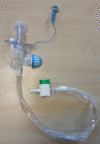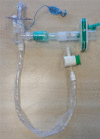Tracheostomy care and decannulation during the COVID-19 pandemic. A multidisciplinary clinical practice guideline
- PMID: 32556788
- PMCID: PMC7299456
- DOI: 10.1007/s00405-020-06126-0
Tracheostomy care and decannulation during the COVID-19 pandemic. A multidisciplinary clinical practice guideline
Abstract
Purpose: Traditional critical care dogma regarding the benefits of early tracheostomy during invasive ventilation has had to be revisited due to the risk of COVID-19 to patients and healthcare staff. Standard practises that have evolved to minimise the risks associated with tracheostomy must be comprehensively reviewed in light of the numerous potential episodes for aerosol generating procedures. We meet the urgent need for safe practise standards by presenting the experience of two major London teaching hospitals, and synthesise our findings into an evidence-based guideline for multidisciplinary care of the tracheostomy patient.
Methods: This is a narrative review presenting the extensive experience of over 120 patients with tracheostomy, with a pragmatic analysis of currently available evidence for safe tracheostomy care in COVID-19 patients.
Results: Tracheostomy care involves many potentially aerosol generating procedures which may pose a risk of viral transmission to staff and patients. We make a series of recommendations to ameliorate this risk through infection control strategies, equipment modification, and individualised decannulation protocols. In addition, we discuss the multidisciplinary collaboration that is absolutely fundamental to safe and effective practise.
Conclusion: COVID-19 requires a radical rethink of many tenets of tracheostomy care, and controversy continues to exist regarding the optimal techniques to minimise risk to patients and healthcare workers. Safe practise requires a coordinated multidisciplinary team approach to infection control, weaning and decannulation, with integrated processes for continuous prospective data collection and audit.
Keywords: COVID; Multidisciplinary; Novel coronavirus; Tracheostomy care.
Conflict of interest statement
None of the authors declare any conflict of interest.
Figures
Similar articles
-
Multidisciplinary Safety Recommendations After Tracheostomy During COVID-19 Pandemic: State of the Art Review.Otolaryngol Head Neck Surg. 2021 May;164(5):984-1000. doi: 10.1177/0194599820961990. Epub 2020 Sep 22. Otolaryngol Head Neck Surg. 2021. PMID: 32960148 Free PMC article. Review.
-
Recommendation of a practical guideline for safe tracheostomy during the COVID-19 pandemic.Eur Arch Otorhinolaryngol. 2020 Aug;277(8):2173-2184. doi: 10.1007/s00405-020-05993-x. Epub 2020 Apr 21. Eur Arch Otorhinolaryngol. 2020. PMID: 32314050 Free PMC article. Review.
-
Critical Care Guidance for Tracheostomy Care During the COVID-19 Pandemic: A Global, Multidisciplinary Approach.Am J Crit Care. 2020 Nov 1;29(6):e116-e127. doi: 10.4037/ajcc2020561. Am J Crit Care. 2020. PMID: 32929453 Review.
-
Tracheostomy guidelines developed at a large academic medical center during the COVID-19 pandemic.Head Neck. 2020 Jun;42(6):1291-1296. doi: 10.1002/hed.26191. Epub 2020 Apr 27. Head Neck. 2020. PMID: 32329926 Free PMC article.
-
Controversies in Tracheostomy for Patients With COVID-19: The When, Where, and How.Respir Care. 2020 Nov;65(11):1767-1772. doi: 10.4187/respcare.08100. Epub 2020 Sep 1. Respir Care. 2020. PMID: 32873749 Review.
Cited by
-
Multidisciplinary Safety Recommendations After Tracheostomy During COVID-19 Pandemic: State of the Art Review.Otolaryngol Head Neck Surg. 2021 May;164(5):984-1000. doi: 10.1177/0194599820961990. Epub 2020 Sep 22. Otolaryngol Head Neck Surg. 2021. PMID: 32960148 Free PMC article. Review.
-
Effect of Multidisciplinary Team Collaborative Nursing Model Combined with Mind Mapping Teaching Method on Postoperative Complications and Mental Health of Patients with Advanced Pancreatic Cancer.Iran J Public Health. 2022 Mar;51(3):535-543. doi: 10.18502/ijph.v51i3.8929. Iran J Public Health. 2022. PMID: 35865063 Free PMC article.
-
Case Report- Prevention strategies for permanent tracheostomy tube migration into the left main bronchus in tracheostomized patients.F1000Res. 2025 Apr 1;14:372. doi: 10.12688/f1000research.163217.1. eCollection 2025. F1000Res. 2025. PMID: 40376448 Free PMC article.
-
The Role of Ancient Greek Physicians in the Development of Tracheostomy: Pioneering Airway Interventions and Early Thoracic Surgery.Clin Pract. 2025 May 13;15(5):93. doi: 10.3390/clinpract15050093. Clin Pract. 2025. PMID: 40422274 Free PMC article. Review.
-
Tracheostomy, ventilatory wean, and decannulation in COVID-19 patients.Eur Arch Otorhinolaryngol. 2021 May;278(5):1595-1604. doi: 10.1007/s00405-020-06187-1. Epub 2020 Aug 1. Eur Arch Otorhinolaryngol. 2021. PMID: 32740720 Free PMC article.
References
-
- Intensive Care National Audit and Research Centre (2020). ICNARC report on COVID-19 in critical care. https://www.icnarc.org/Our-Audit/Audits/Cmp/Reports. Accessed 7 May 2020
Publication types
MeSH terms
LinkOut - more resources
Full Text Sources
Medical



